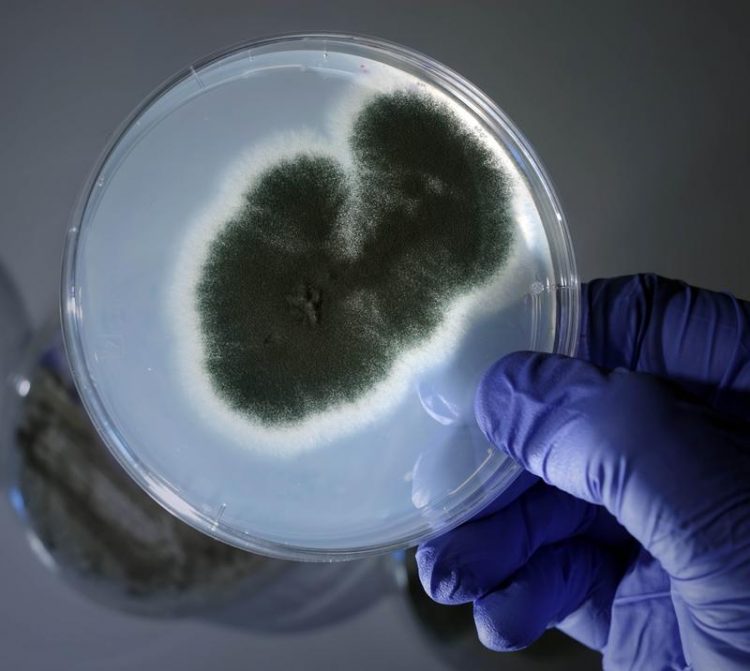How a fungus can cripple the immune system

Petri dish with the fungus Aspergillus fumigatus. Credit: Jan-Peter Kasper/FSU
It is everywhere – and it is extremely dangerous for people with a weakened immune system. The fungus Aspergillus fumigatus occurs virtually everywhere on Earth, as a dark grey, wrinkled cushion on damp walls or in microscopically small spores that blow through the air and cling to wallpaper, mattresses and floors.
Healthy people usually have no problem if spores find their way into their body, as their immune defence system will put the spores out of action.
However, the fungus can threaten the lives of people with a compromised immune system, such as AIDS patients or people who are immunosuppressed following an organ transplantation.
An international research team led by Prof. Oliver Werz of Friedrich Schiller University, Jena, has now discovered how the fungus knocks out the immune defences, enabling a potentially fatal fungal infection to develop.
The researchers present their findings in the current issue of the specialist journal Cell Chemical Biology (DOI: 10.1016/j.chembiol.2019.01.001).
Among other factors, it is gliotoxin – a potent mycotoxin – that is responsible for the pathogenicity of Aspergillus fumigatus. “It was known,” says study manager Werz of the Institute of Pharmacy at the University of Jena, “that this substance has an immunosuppressive effect, which means that it weakens the activity of cells of the immune defence system.”
However, it had not been clear previously how exactly this happens. Werz and his team colleagues have now studied this in detail and have clarified the underlying molecular mechanisms.
Immune cells communicate with one another
To achieve this, the researchers brought immune cells into contact with synthetically produced gliotoxin. These cells, called neutrophilic granulocytes, represent the first line of the immune defence system.
“Their task is to detect pathogens and eliminate them,” explains Werz. As soon as such a cell comes into contact with a pathogen, for example a fungus, it releases specific messenger substances (leukotrienes) into the blood, which attract other immune cells. Once a sufficiently large number of immune cells has gathered, they can render the intruder harmless.
Mycotoxin switches off enzyme
This does not happen if the pathogen Aspergillus fumigatus is involved. As the Jena scientists were able to show, gliotoxin ensures that production of the messenger substance leukotrieneB4 in the neutrophilic granulocytes is inhibited, so that they are unable to send a signal to other immune cells.
This is caused by a specific enzyme (LTA4 hydrolase) being switched off by the mycotoxin. “This interrupts communication between the immune cells and destroys the defence mechanism. As a result, it is easy for spores – in this case the fungus – that enter the organism to infiltrate tissues or organs,” says Werz.
Cooperation in Cluster of Excellence ‘Balance of the Microverse’
For their study, Prof. Werz and his colleagues collaborated with researchers from the Leibniz Institute for Natural Product Research and Infection Biology (Hans Knöll Institute). As part of the Collaborative Research Centre ChemBioSys and the Jena Cluster of Excellence ‘Balance of the Microverse’, they cooperated with the working groups led by Prof. Axel Brakhage and Prof. Christian Hertweck, which contributed their expertise in mycology and natural product synthesis. Additional partners are research groups from the Universities of Frankfurt and Naples, as well as the Karolinska Institute in Stockholm.
Prof. Oliver Werz
Institute of Pharmacy of Friedrich Schiller University, Jena
Philosophenweg 14, 07743 Jena, Germany
Tel.: +49 (0)3641 / 949801
E-mail: oliver.werz@uni-jena.de
König S et al. Gliotoxin from Aspergillus fumigatus Abrogates Leukotriene B4 Formation through Inhibition of Leukotriene A4 Hydrolase, Cell Chemical Biology 26, 1-11 (2019), DOI: 10.1016/j.chembiol.2019.01.001, https://www.cell.com/cell-chemical-biology/fulltext/S2451-9456(19)30001-7
Media Contact
More Information:
http://www.uni-jena.de/All latest news from the category: Life Sciences and Chemistry
Articles and reports from the Life Sciences and chemistry area deal with applied and basic research into modern biology, chemistry and human medicine.
Valuable information can be found on a range of life sciences fields including bacteriology, biochemistry, bionics, bioinformatics, biophysics, biotechnology, genetics, geobotany, human biology, marine biology, microbiology, molecular biology, cellular biology, zoology, bioinorganic chemistry, microchemistry and environmental chemistry.
Newest articles

Trotting robots reveal emergence of animal gait transitions
A four-legged robot trained with machine learning by EPFL researchers has learned to avoid falls by spontaneously switching between walking, trotting, and pronking – a milestone for roboticists as well…

Innovation promises to prevent power pole-top fires
Engineers in Australia have found a new way to make power-pole insulators resistant to fire and electrical sparking, promising to prevent dangerous pole-top fires and reduce blackouts. Pole-top fires pose…

Possible alternative to antibiotics produced by bacteria
Antibacterial substance from staphylococci discovered with new mechanism of action against natural competitors. Many bacteria produce substances to gain an advantage over competitors in their highly competitive natural environment. Researchers…





















